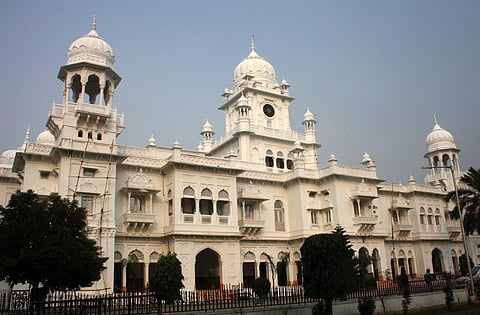New techniques by KGMU in Lucknow to make dental implants less painful & more durable
The Indian Prosthodontic Society on Thursday conferred King George's Medical University in Lucknow with the two prestigious awards for indigenously developing effective techniques for dental implants. Awarded with the first and second pizes for the year 2021, both the procedures effectively reduce the time of dental implants and make them durable and less painful. It has also been reported that these procedures reduce the chances of infection.
Reduced chances of side effects!
[rebelmouse-proxy-image https://media.rbl.ms/image?u=%2Fwp-content%2Fuploads%2F2020%2F11%2Fdental-implants-1.jpeg&ho=https%3A%2F%2Fwww.lovettdentistrynorthheights.com&s=70&h=fba445e00828952f8945a0791a6f358c317b5ca02435928104b2bbf1c9980450&size=980x&c=150934640 photo_credit="" pin_description="" dam="0" site_id=20074994 caption="" photo_credit_src="https://www.lovettdentistrynorthheights.com/wp-content/uploads/2020/11/dental-implants-1.jpeg" crop_info="%7B%22image%22%3A%20%22https%3A//media.rbl.ms/image%3Fu%3D%252Fwp-content%252Fuploads%252F2020%252F11%252Fdental-implants-1.jpeg%26ho%3Dhttps%253A%252F%252Fwww.lovettdentistrynorthheights.com%26s%3D70%26h%3Dfba445e00828952f8945a0791a6f358c317b5ca02435928104b2bbf1c9980450%26size%3D980x%26c%3D150934640%22%7D" expand=1]
The Prosthidonitic Department of the King George's Medical University (KGMU) has created two techniques that effectively improve the procedure of getting dental implants in Lucknow. A dental implant primarily includes the replacement of tooth roots with a screw-like post and a false tooth fixture. This artificial addition looks and functions like a real tooth.
According to Professor Balendra Pratap Singh, "We sterilised the bone gums of implant site after removing the decayed tooth with ultraviolet rays instead of traditional disinfectant, and then fixed the metal post. The process reduced the rate of degeneration of jaw bone by restricting the accumulation of bacteria. As a result, the implant stayed for a longer period with less chances of infection."
The first prize ₹1 lakh has been awarded to this technique developed by Professor Singh and junior resident Dr Shahid A Shah. Reportedly, the method was tested successfully in 2017 on 80 patients who were observed for over a year in follow-ups. Common side-effects such as infection, injury or damage, pain, numbness and tingling in gums and lips were considerably less in these cases, unlike those whose implant was done without UV treatment.
"Post implant, often, the jawbone degenerates by 2mm, but in our technique, the degeneration was not over 0.75mm," he said. Besides the honourary cash prize, the study based on this technique, 'Bio and Prosthetic Impact of Platelet Rich Plasma and Ultraviolet Rays on Tooth Implant' has been published in the journal of Indian Prosthodontics Society this year.
3D CBCT Technique bags the second prize
[rebelmouse-proxy-image https://media.rbl.ms/image?u=%2Fwp-content%2Fuploads%2F2020%2F03%2FKing.jpg&ho=https%3A%2F%2Fwww.orissapost.com&s=868&h=f0c1c18943cb70e7d0926c5920d519b13402683aeeb48cac9d940303175b862a&size=980x&c=1085149498 photo_credit="" pin_description="" dam="0" site_id=20074994 caption="" photo_credit_src="https://www.orissapost.com/wp-content/uploads/2020/03/King.jpg" crop_info="%7B%22image%22%3A%20%22https%3A//media.rbl.ms/image%3Fu%3D%252Fwp-content%252Fuploads%252F2020%252F03%252FKing.jpg%26ho%3Dhttps%253A%252F%252Fwww.orissapost.com%26s%3D868%26h%3Df0c1c18943cb70e7d0926c5920d519b13402683aeeb48cac9d940303175b862a%26size%3D980x%26c%3D1085149498%22%7D" expand=1]
Developed by Professor Kaushlendra Singh and junior resident Dr Puran Chand, the technique which won the second prize used 3D CBCT for implants. Reportedly, the study based on this method was titled 'A randomized controlled trial for evaluation of bone density changes around immediate functionally and non-functionally loaded implants using 3D CBCT'.
"In the traditional method, no gap is left between the implanted tooth and natural teeth over or below it. The other teeth put pressure on the implanted tooth, hence, after fixation of metal post, patients had to wait for 4-6 months for it to be firmly installed in position before putting the crown cap over it," explained Prof Kaushlendra Singh.
"In our technique successfully tried on 80 patients in 2018, we kept a gap of 0.44mm between the implanted tooth and teeth vertically above or below. Since there was no pressure on the implanted tooth, it allowed us to cap the metal post with a crown soon after the surgery. Follow up of the patients for over a year revealed that the site healed faster and implant was firm," he said.
To get all the latest content, download our mobile application. Available for both iOS & Android devices.

